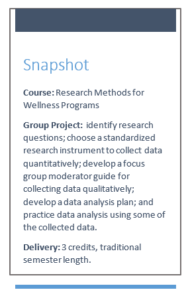Introduction
The reality is that most online courses have what we call “traditional discussions,” which follow the read-write-post (and perhaps reply to a peer or two) pattern. Even if the discussion questions are interesting, both instructors and students can get tired of the same old routine. We recommend trying any of these five “twists” on traditional discussions in the next online course you work on. These activities encourage student engagement and critical thinking, and they might help you feel more connected to your students as well!

Twist 1: Adding Images of Examples
What is it?: For this twist, ask students to post images along with their written responses in the discussion forum.
Why we like it: It’s personal, motivates the students, and is a great way to connect at a distance. Erin Ratelis, an online instructor, said, “It not only feels different for the students, but it is also a different type of activity which will stand out for them. It leverages a different technology, and photos are a great visual tool to solidify class insights. It requires students to explore class topics through a very personal lens (no pun intended).”
Field-tested example: In Erin’s course, she asked students to go to a retail environment in their community and find ten ways that consumer marketers influence purchasing decisions. She asked students to post photos but made it optional. Many students chose to include pictures of examples, such as retail displays at Target and other stores. Students even commented directly in their posts about how much they enjoyed the assignment.
Best used for: Drawing attention to real-life examples of course concepts. Think of it as a field trip. For example, a discussion of barriers to a healthy community could include photos from students’ own communities.
Tips and tricks: It is important to remind students about privacy concerns. For example, if they are taking photos at work and sharing them, it would be a good idea to get permission first. Consider beginning the course with an activity like this to pique interest, then doing it again about halfway through the course to add some momentum.
Twist 2: External Discussion and Reflection
What is it?: This twist asks students to have a real-time, 30-minute discussion with someone (in person, on the phone, via Skype, etc.) followed by a written reflection.
Why we like it: The student needs to know enough about the subject matter to have a 30-minute discussion. Instructor Rachel Portinga commented that “Students are asked to discuss information with another person, who may not understand the [content] as well, and that could lead to the student teaching someone else, and therefore reinforcing the information they have learned.”
Field-tested example: In Rachel’s class, she asked students to have a real-time discussion with someone in their life about whether to legalize drugs such as Marijuana, Adderall, or Ritalin without prescriptions. In their posts, students summarized their discussions and shared their conclusions about whether to legalize the drug of choice.
Best used for: We especially like this twist for courses that might be hard to have traditional discussions in, like a self-paced course or program that isn’t cohort based. Think about ways you could get students to connect with community members or professionals in their field with this discussion. For example, a student in a statistics course could discuss the importance of collecting poverty rate information for the U.S. Census Bureau.
Tips and tricks: Some students might have a hard time finding someone to talk to. Remember that students can also call or Skype someone if they’re unable to meet with someone in person.
Twist 3: Debate
What is it?: For this twist, students choose a particular viewpoint on a topic. Students post their viewpoint supported by research, wait for a response from a peer with a different viewpoint, and then reply with a rebuttal. In some cases, students write a final reflection on what viewpoint they agree with (or what other information might be necessary before they can decide).
Why we like it: Crafting an argument and approaching an issue from a specific viewpoint can be motivating and fun. Online instructor Todd Wilkinson agrees, saying, “Debating with other students provides extra motivation to make good arguments and present oneself well, which are both important in this type of work.”
Field-tested example: In Todd’s course, he picked which side students argued for on the topic of how to best support healthy behavior (more specifically, from an individual level or an institutional level). He asked them to incorporate learning resources from the lesson to support their arguments. In their posts, students supported their arguments with references and explained where they were wavering in their arguments, creating a natural feel with the back-and-forth post-and-response mechanics.
Best used for: If you have a topic where students can choose a viewpoint or a side, a debate is likely a better choice than a traditional discussion. For instance, students in an accounting course can debate the ethics of a particular case.
Tips and tricks: We highly recommend posting a “netiquette” statement as well as a schedule for the debate so there is enough time to go back and forth a couple of times.
Twist 4: Role-Play
What is it?: Students are assigned to particular viewpoints of a topic and then do some research to form and support their arguments. Then, after posting to the discussion board, students review the perspectives of their peers and write a reflection based upon information from all roles and reflections.
Why we like it: Students put themselves in another person’s shoes for a while. This kind of post can be powerful while also providing a safe place for students to explore an issue from a different perspective than their own. Instructor Rachel Portinga commented, “In general, students appear to be more engaged when you ask them to change their format (and to see an issue from someone else’s perspective).”
Field-tested example: In Rachel’s course, she asks students to consider vaccinations from the role assigned to them (e.g., the parent of a child with a healthy immune system, a college student living on campus, a doctor, a community member, or a parent of an immunodeficient child). Students crafted posts that were realistic representations of their assigned roles.
Best used for: This is a great way to provide a lens through which to explore controversial or sensitive topics with three or more perspectives. It also helps amplify viewpoints that might not often be heard. For example, students in an ecology course discussing the impact of climate change can adopt the roles of a CEO of an automobile manufacturer, an environmental research biologist, an EPA representative, a resident of Norfolk, Virginia, or a Mayor of Los Angeles.
Tips and tricks: Ask students to write their role at the top of the post to remind everyone that students are just playing a role. In one case, the instructor read an intense and very affecting post about how her student’s sister died in a car accident recently only to realize the student was being creative and playing a role instead of actually living through that particular trauma.
Twist 5: Fishbowl
What is it?: This strategy is similar to a traditional discussion, but only half of the class participates in the discussion at a time (i.e., inside the fishbowl). The other half observes the ongoing discussion while pausing to reflect on given questions (i.e., outside the fishbowl).
Why we like it: Students get to reflect on the discussion itself, which can be very enlightening and might even make them see discussions in a new way in the future. Instructor Chris Vandenhouten shared that, “Much learning takes place in observing others engaging in discussion. It allows a student to reflect on multiple student perspectives instead of selecting just one or two to review.”
Field-tested example: In Chris’s course, she asked half the class to respond to a traditional discussion question and asked the other half to observe the ongoing discussion and write a response paper including one fact learned, one surprising thing learned, their most salient takeaway, one thing they learned about themselves, and an area they might like to explore in more depth. Later in the semester, the groups switched roles.
Best used for: Switching things up a couple of times in larger classes is great for getting students to reflect on their own learning. It can also encourage students to step back to analyze the flow of the discussion. For example, students can be asked to state which positions seemed to be the most popular initially and whether this changed during the discussion (and, if so, why). Students tend not to observe the major shifts in a discussion when they are focused on addressing a particular topic, and this exercise can help them develop that ability.
Tips and tricks: Use this for at least two discussions so students can switch roles. This is best for larger classes (12+ students). The activity creates a bit more work (for example, it may require using two rubrics: one for the students inside the fishbowl and one for the students outside the fishbowl), but instructors have said it’s totally worth it.
Try one or more of these strategies and see how a little twist can add some zest to your online discussions!
Note: Laurie Berry and Kristin Kowal wrote this article based on their presentation “Discussion on the Rocks? Add a Twist of Fresh Alternatives!”. This article originally appeared in Magna publication’s Newsletter, The Teaching Professor. Link to original article: https://www.teachingprofessor.com/topics/online-learning/teaching-strategies-techniques/five-new-twists-for-online-discussions/



